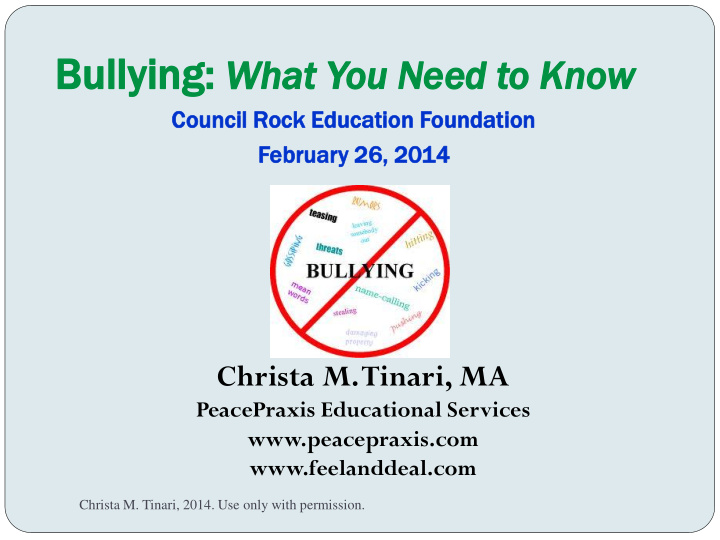



Bullying ullying: : Wha hat You u Ne Need d to Know ow Council cil Rock Education on Foundatio tion Februar ary 26, 2014 14 Christa M. Tinari, MA PeacePraxis Educational Services www.peacepraxis.com www.feelanddeal.com Christa M. Tinari, 2014. Use only with permission.
What is Bullying?
Behavior viors Pyramid amid Considerations Bullying • Child’s age • Knowledge Conflict • Ability Teasing • Context Unintentional/Unskilled Behaviors Christa M. Tinari, 2014. Use only with permission.
De Defin inition ition of Bu f Bullyi llying ng Intentional Aggressive behavior Causes fear, harm, humiliation Repeated Power imbalance Christa M. Tinari, 2014. Use only with permission.
PA Bul A Bullying lying Le Legi gislatio lation “ Pervasive, persistent, severe” Threatening- disrupts order- interferes with education Defines “school setting” Requires consequences Recommends prevention & intervention Christa M. Tinari, 2014. Use only with permission.
PA Bul A Bullying lying Le Legi gislatio lation Requires school policy (2009) Website; visibly posted Review with students annually Identify reporting procedures Review every 3 years PA School Board Model Policy Christa M. Tinari, 2014. Use only with permission.
Prevalence alence of Bu f Bullyi llying ng (Olweu eus s & Li Limber er, , 2013) 3) Surveyed 300,000 students; analyzed 20,000 3 rd -12 th grades 16% report being bullied; 7% bully Peak in 3 rd -4 th grade Multiple locations Most likely to report to parent! Christa M. Tinari, 2014. Use only with permission.
Wh What at kin inds ds of of bu bull llying ying ha happ ppen en th the mo most? t? (Olweu eus s & Li Limber er, , 2013) 3) Verbal Relational (exclusion) Physical Cyber Christa M. Tinari, 2014. Use only with permission.
Cybe ber-bullying bullying No adult presence Anonymity Lowers inhibitions Permanence Dissemination/Replication Networked community www.embracingdigitalyouth.org Christa M. Tinari, 2014. Use only with permission.
Respon ponding ding to Cybe ber-bullyi bullying ng Discuss rules and scenarios Commit to “no abuse” policy Access to passwords, technology, etc. Don’t retaliate Use positive slamming (to support) Print & save evidence Report to site, school, police Christa M. Tinari, 2014. Use only with permission.
Special Considerations
Suicide: What’s the Connection? “Discussing bullying as directly caused by or as the only cause of suicide is not helpful...” Bullying and suicidal behaviors are related. However, the majority of youth who are bullied do not attempt suicide. Youth who do attempt suicide experience multiple risk factors. Bullying-and-Suicide:- What’s -the-Connection? CDC, 2013. Christa M. Tinari, 2014. Use only with permission.
LGB GBTQ TQ an and d Ge Gend nder r Bullying risk factor: gender variance Higher rates of bullying victimization (2-3x) Higher risk for suicide (4x) Increased social isolation Developing respect for differences is key! www.glsen.org Christa M. Tinari, 2014. Use only with permission.
Ba Barr rrier iers s to Repo porting ting Not recognizing bullying Lack of connectedness to adults Fear reporting will make it worse “No one will understand” Wants to belong Blames self Christa M. Tinari, 2014. Use only with permission.
Sig igns ns of Bu f Bullying llying Change in mood; appetite or sleeping Change in friends, socializing Avoidance of school or activities Secrecy around technology use Injuries, property damage Academic problems Christa M. Tinari, 2014. Use only with permission.
What Can Parents Do?
Wh When n Your ur Chi hild ld Repo ports ts Listen carefully Ask questions about context and specific actions Support your child Display calm and confidence Gather “evidence” Identify actions your child can take Christa M. Tinari, 2014. Use only with permission.
Par artner tnering ing wit ith h School ol Contact teacher (don’t wait until crisis) Refrain from accusations Identify specific behaviors Ask teacher what insights s/he may have Request: investigation process immediate reasonable action planned check-back meeting/s Christa M. Tinari, 2014. Use only with permission.
Youth uth Voic ices Project roject www ww.y .youth uthvoicespr cesproject.co oject.com Surveyed of 13,000 youth grades 5-12 Which actions were perceived as being most helpful to students? Support strategies! (Not confrontational ones) Christa M. Tinari, 2014. Use only with permission.
Peer r S Supp uppor ort t Str Strat ategies gies Be a buddy~ invite! Use “balancing” technique. Avoid people who gossip, exclude, etc. Support target in reporting. Listen to target. Tell “bully” you don’t approve. Check in with target after school. Christa M. Tinari, 2014. Use only with permission.
Discussion and Q&A
Recommend
More recommend